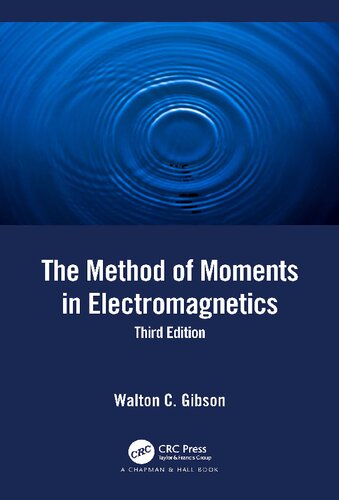

Most ebook files are in PDF format, so you can easily read them using various software such as Foxit Reader or directly on the Google Chrome browser.
Some ebook files are released by publishers in other formats such as .awz, .mobi, .epub, .fb2, etc. You may need to install specific software to read these formats on mobile/PC, such as Calibre.
Please read the tutorial at this link. https://ebooknice.com/page/post?id=faq
We offer FREE conversion to the popular formats you request; however, this may take some time. Therefore, right after payment, please email us, and we will try to provide the service as quickly as possible.
For some exceptional file formats or broken links (if any), please refrain from opening any disputes. Instead, email us first, and we will try to assist within a maximum of 6 hours.
EbookNice Team

Status:
Available4.5
8 reviewsThe Method of Moments in Electromagnetics, Third Edition details the numerical solution of electromagnetic integral equations via the Method of Moments (MoM). Previous editions focused on the solution of radiation and scattering problems involving conducting, dielectric, and composite objects. This new edition adds a significant amount of material on new, state-of-the art compressive techniques. Included are new chapters on the Adaptive Cross Approximation (ACA) and Multi-Level Adaptive Cross Approximation (MLACA), advanced algorithms that permit a direct solution of the MoM linear system via LU decomposition in compressed form. Significant attention is paid to parallel software implementation of these methods on traditional central processing units (CPUs) as well as new, high performance graphics processing units (GPUs). Existing material on the Fast Multipole Method (FMM) and Multi-Level Fast Multipole Algorithm (MLFMA) is also updated, blending in elements of the ACA algorithm to further reduce their memory demands.
The Method of Moments in Electromagnetics is intended for students, researchers, and industry experts working in the area of computational electromagnetics (CEM) and the MoM. Providing a bridge between theory and software implementation, the book incorporates significant background material, while presenting practical, nuts-and-bolts implementation details. It first derives a generalized set of surface integral equations used to treat electromagnetic radiation and scattering problems, for objects comprising conducting and dielectric regions. Subsequent chapters apply these integral equations for progressively more difficult problems such as thin wires, bodies of revolution, and two- and three-dimensional bodies. Radiation and scattering problems of many different types are considered, with numerical results compared against analytical theory as well as measurements.